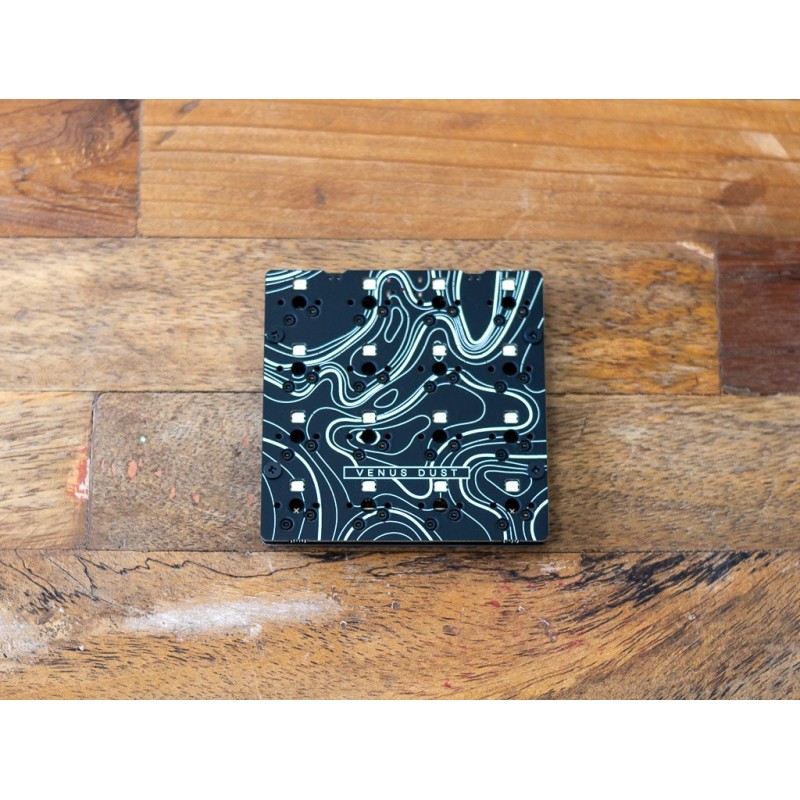




A module for building a mechanical keyboard with 16 buttons in a 4x4 layout and LED backlight for each button. It is based on the RP2040 microcontroller known from the popular Raspberry Pi Pico boards. It is powered and programmed with a USB type C connector using the CircuitPython language. The hot-swap outlets will work with Cherry-MX compatible switches that have a recess on the underside for surface mount LEDs. It works well as an addition to the support of popular programs for streaming, graphic processing or for pasting frequently used text or code fragments. Documentation with a library and examples in Python is available in the GitHub repository.
Manufacturer BTC Korporacja sp. z o. o. Lwowska 5 05-120 Legionowo Poland sprzedaz@kamami.pl 22 767 36 20
Responsible person BTC Korporacja sp. z o. o. Lwowska 5 05-120 Legionowo Poland sprzedaz@kamami.pl 22 767 36 20
Cable with USB type A and USB type C 2.0 plugs, cable length 1 m. A switch has been mounted on the cable. The product is intended for use with the Raspberry Pi 4B.
No product available!
Cable with USB typ A and USB typ C connectors, cable length 1 m. LANBERG CA-USBO-10CC-0010-BK
Cable with USB typ A and USB typ C connectors, cable length 1,8 m. LANBERG CA-USBO-10CC-0018-BK
Cable with USB typ A and USB typ C connectors, compatible with Quick Charge 3.0, cable length 1,8m. LANBERG
Mechanical mini keyboard with 16 buttons and backlight. Based on the RP2040 chip, it uses Kailh Speed Gold buttons. Pimoroni PIM565
Mechanical mini keyboard with 16 buttons and backlight. Based on the RP2040 chip, it uses Kailh Speed Silver buttons. Pimoroni PIM561
No product available!
Conductivity Sensor Switch DFRobot is a touch button that allows you to change the sensor output status by connecting terminals (positive and negative) using metal, human body or fruit and plants. It is powered by 3.3 ... 5 V. DFRobot SEN0223
No product available!
Switch module with an interlock. DFRobot DFR0423
Module with a button and yellow LED backlight. The board is equipped with a Grove connector and communicates via a digital interface. Seeed Studio 111020045
Module with a button, LED diode and a yellow cap. DFRobot DFR0029-Y
Module with a button and yellow LED backlight. The board is equipped with a Gravity connector and communicates via a digital interface. DFRobot DFR0785-Y
No product available!
Module with a bistable button and yellow LED backlight. The board is equipped with a Gravity connector and communicates via a digital interface. DFRobot DFR0785-Y
No product available!
Membrane keypad module with 12 (3x4) buttons. It is equipped with a tape terminated with a 7-pin connector
Module with a button and blue LED backlight. The board is equipped with a Gravity connector and communicates via a digital interface. DFRobot DFR0785-B
Module with a button, LED diode and a red cap. DFRobot DFR0029-R
Module with a button and blue LED backlight. The board is equipped with a Grove connector and communicates via a digital interface. Seeed Studio 111020046
Touch keyboard module with 16 buttons based on the TTP229 chip. It is equipped with a connector with derived signals and a power supply diode
Mechanical keyboard module with LED backlight, encoder and display. Based on the RP2040 microcontroller. Adafruit 5100
No product available!
Module for 4 mechanical buttons with LED backlight in the form of NeoPixel diodes. Communicates via I2C. Adafruit 4980
Touch keyboard module with 8 buttons and one line sensor (slider)
Keyboard module with 10 tact switch buttons. The state of the buttons can be read using digital pins or a common analog output. DFRobot DFR0792
The touch sensor module (touch button) can be used as a replacement for traditional mechanical buttons. It operates based on the TTP223-B system, which measures the capacity of the metal field on the module. The module has a connector in accordance with the Grove standard. Seeed studio 101020037

A module for building a mechanical keyboard with 16 buttons and backlight. Based on the RP2040 chip, it has sockets compatible with Cherry-MX switches. Pimoroni PIM567
